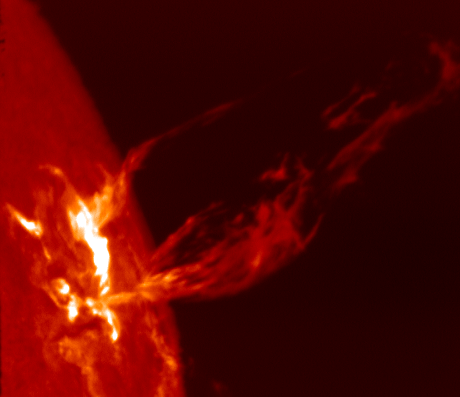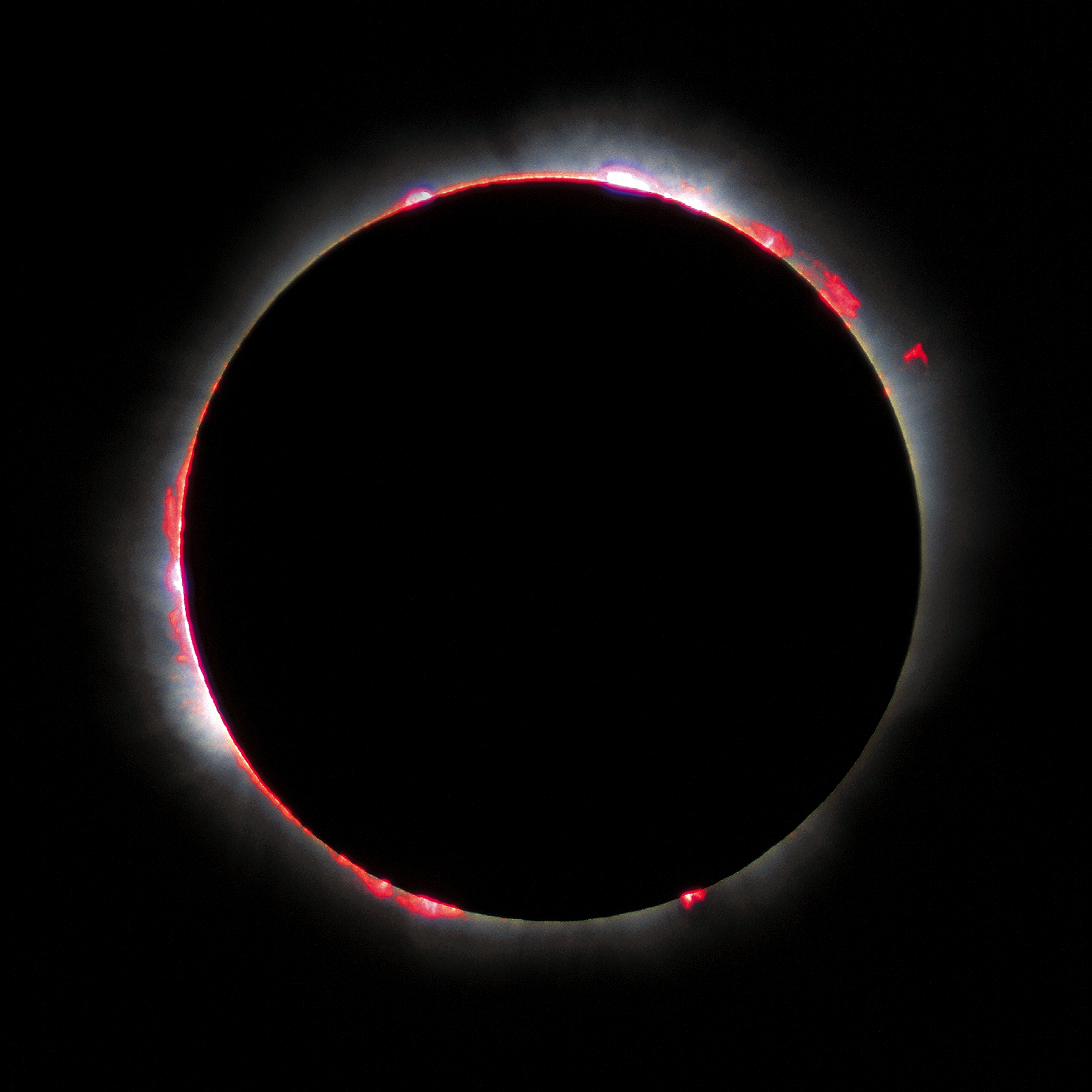|
HD 10180
HD 10180, also designated 2MASS J01375356-6030414, is a Sun-like star in the southern constellation Hydrus that is notable for its large planetary system. Since its discovery, at least six exoplanets have been observed orbiting it, and some studies have proposed up to nine potential planets, which would make it potentially the largest of all known planetary systems, including the Solar System. Characteristics Based upon parallax measurements, it is located at a distance of from Earth. The apparent visual magnitude of this star is 7.33, which is too faint to be viewed with the naked eye although it can be readily observed with a small telescope. At a declination of −60°, this star cannot be seen at latitudes north of the tropics. HD 10180 is a G1V-type star, and thus generates energy at its core through the thermonuclear fusion of hydrogen. The mass of this star is estimated as 6% greater than the Sun's mass, it has a radius of 120% that of the Sun, and is radiating ... [...More Info...] [...Related Items...] OR: [Wikipedia] [Google] [Baidu] |
Declination
In astronomy, declination (abbreviated dec; symbol ''δ'') is one of the two angles that locate a point on the celestial sphere in the equatorial coordinate system, the other being hour angle. Declination's angle is measured north or south of the celestial equator, along the hour circle passing through the point in question. The root of the word ''declination'' (Latin, ''declinatio'') means "a bending away" or "a bending down". It comes from the same root as the words ''incline'' ("bend foward") and ''recline'' ("bend backward"). In some 18th and 19th century astronomical texts, declination is given as ''North Pole Distance'' (N.P.D.), which is equivalent to 90 – (declination). For instance an object marked as declination −5 would have an N.P.D. of 95, and a declination of −90 (the south celestial pole) would have an N.P.D. of 180. Explanation Declination in astronomy is comparable to geographic latitude, projected onto the celestial sphere, and right ascension is ... [...More Info...] [...Related Items...] OR: [Wikipedia] [Google] [Baidu] |
HD 10180 E
HD 10180, also designated 2MASS J01375356-6030414, is a Sun-like star in the southern constellation Hydrus that is notable for its large planetary system. Since its discovery, at least six exoplanets have been observed orbiting it, and some studies have proposed up to nine potential planets, which would make it potentially the largest of all known planetary systems, including the Solar System. Characteristics Based upon parallax measurements, it is located at a distance of from Earth. The apparent visual magnitude of this star is 7.33, which is too faint to be viewed with the naked eye although it can be readily observed with a small telescope. At a declination of −60°, this star cannot be seen at latitudes north of the tropics. HD 10180 is a G1V-type star, and thus generates energy at its core through the thermonuclear fusion of hydrogen. The mass of this star is estimated as 6% greater than the Sun's mass, it has a radius of 120% that of the Sun, and is radiating ... [...More Info...] [...Related Items...] OR: [Wikipedia] [Google] [Baidu] |
HD 10180 C
HD 10180 c is an exoplanet approximately 130 light-years away in the constellation Hydrus. It was discovered in 2010 using the radial velocity method. With a minimum mass comparable to that of Neptune, it is of the class of planets known as Hot Neptune A hot Neptune or Hoptune is a type of giant planet with a mass similar to that of Uranus or Neptune orbiting close to its star, normally within less than 1 AU. The first hot Neptune to be discovered with certainty was Gliese 436 b in 2007, an ex ...s. Dynamical simulations suggest that if the mass gradient was any more than a factor of two, the system would not be stable. While planet c does not exist in any mean motion resonances, both planets with adjacent orbits (b and d) share near resonances with c. References Exoplanets discovered in 2010 Exoplanets detected by radial velocity Hydrus Hot Neptunes {{extrasolar-planet-stub ... [...More Info...] [...Related Items...] OR: [Wikipedia] [Google] [Baidu] |
Astronomical Unit
The astronomical unit (symbol: au, or or AU) is a unit of length, roughly the distance from Earth to the Sun and approximately equal to or 8.3 light-minutes. The actual distance from Earth to the Sun varies by about 3% as Earth orbits the Sun, from a maximum ( aphelion) to a minimum ( perihelion) and back again once each year. The astronomical unit was originally conceived as the average of Earth's aphelion and perihelion; however, since 2012 it has been defined as exactly (see below for several conversions). The astronomical unit is used primarily for measuring distances within the Solar System or around other stars. It is also a fundamental component in the definition of another unit of astronomical length, the parsec. History of symbol usage A variety of unit symbols and abbreviations have been in use for the astronomical unit. In a 1976 resolution, the International Astronomical Union (IAU) had used the symbol ''A'' to denote a length equal to the ast ... [...More Info...] [...Related Items...] OR: [Wikipedia] [Google] [Baidu] |
Stellar Magnetic Field
A stellar magnetic field is a magnetic field generated by the motion of conductive plasma inside a star. This motion is created through convection, which is a form of energy transport involving the physical movement of material. A localized magnetic field exerts a force on the plasma, effectively increasing the pressure without a comparable gain in density. As a result, the magnetized region rises relative to the remainder of the plasma, until it reaches the star's photosphere. This creates starspots on the surface, and the related phenomenon of coronal loops. Measurement The magnetic field of a star can be measured by means of the Zeeman effect. Normally the atoms in a star's atmosphere will absorb certain frequencies of energy in the electromagnetic spectrum, producing characteristic dark absorption lines in the spectrum. When the atoms are within a magnetic field, however, these lines become split into multiple, closely spaced lines. The energy also becomes polarized with ... [...More Info...] [...Related Items...] OR: [Wikipedia] [Google] [Baidu] |
Chromosphere
A chromosphere ("sphere of color") is the second layer of a star's atmosphere, located above the photosphere and below the solar transition region and corona. The term usually refers to the Sun's chromosphere, but not exclusively. In the Sun's atmosphere, the chromosphere is roughly in height, or slightly more than 1% of the Sun's radius at maximum thickness. It possesses a homogeneous layer at the boundary with the photosphere. Hair-like jets of plasma, called spicules, rise from this homogeneous region and through the chromosphere, extending up to into the corona above. The chromosphere has a characteristic red color due to electromagnetic emissions in the ''H''α spectral line. Information about the chromosphere is primarily obtained by analysis of its emitted electromagnetic radiation. Chromospheres have also been observed on stars other than the Sun. On large stars, chromospheres sometimes make up a significant proportion of the entire star. For example, the chr ... [...More Info...] [...Related Items...] OR: [Wikipedia] [Google] [Baidu] |
Effective Temperature
The effective temperature of a body such as a star or planet is the temperature of a black body that would emit the same total amount of electromagnetic radiation. Effective temperature is often used as an estimate of a body's surface temperature when the body's emissivity curve (as a function of wavelength) is not known. When the star's or planet's net emissivity in the relevant wavelength band is less than unity (less than that of a black body), the actual temperature of the body will be higher than the effective temperature. The net emissivity may be low due to surface or atmospheric properties, including greenhouse effect. Star The effective temperature of a star is the temperature of a black body with the same luminosity per ''surface area'' () as the star and is defined according to the Stefan–Boltzmann law . Notice that the total ( bolometric) luminosity of a star is then , where is the stellar radius. The definition of the stellar radius is obviously not stra ... [...More Info...] [...Related Items...] OR: [Wikipedia] [Google] [Baidu] |
Solar Luminosity
The solar luminosity (), is a unit of radiant flux ( power emitted in the form of photons) conventionally used by astronomers to measure the luminosity of stars, galaxies and other celestial objects in terms of the output of the Sun. One nominal solar luminosity is defined by the International Astronomical Union to be . This does not include the solar neutrino luminosity, which would add , or , i.e. a total of (the mean energy of the solar photons is 26 MeV and that of the solar neutrinos 0.59 MeV, i.e. 2.27%; the Sun emits photons and as many neutrinos each second, of which per m2 reach the Earth each second). The Sun is a weakly variable star, and its actual luminosity therefore fluctuates. The major fluctuation is the eleven-year solar cycle (sunspot cycle) that causes a quasi-periodic variation of about ±0.1%. Other variations over the last 200–300 years are thought to be much smaller than this. Determination Solar luminosity is related to solar irradiance (the so ... [...More Info...] [...Related Items...] OR: [Wikipedia] [Google] [Baidu] |
Solar Radius
Solar radius is a unit of distance used to express the size of stars in astronomy relative to the Sun. The solar radius is usually defined as the radius to the layer in the Sun's photosphere where the optical depth equals 2/3: :1\,R_ = 6.957\times 10^8 \hbox is approximately 10 times the average radius of Jupiter, about 109 times the radius of the Earth, and 1/215th of an astronomical unit, the distance of the Earth from the Sun. It varies slightly from pole to equator due to its rotation, which induces an oblateness in the order of 10 parts per million. Measurements The unmanned SOHO spacecraft was used to measure the radius of the Sun by timing transits of Mercury across the surface during 2003 and 2006. The result was a measured radius of . Haberreiter, Schmutz & Kosovichev (2008) determined the radius corresponding to the solar photosphere to be . This new value is consistent with helioseismic estimates; the same study showed that previous estimates using inflectio ... [...More Info...] [...Related Items...] OR: [Wikipedia] [Google] [Baidu] |
Solar Mass
The solar mass () is a standard unit of mass in astronomy, equal to approximately . It is often used to indicate the masses of other stars, as well as stellar clusters, nebulae, galaxies and black holes. It is approximately equal to the mass of the Sun. This equates to about two nonillion ( short scale), two quintillion (long scale) kilograms or 2000 quettagrams: The solar mass is about times the mass of Earth (), or times the mass of Jupiter (). History of measurement The value of the gravitational constant was first derived from measurements that were made by Henry Cavendish in 1798 with a torsion balance. The value he obtained differs by only 1% from the modern value, but was not as precise. The diurnal parallax of the Sun was accurately measured during the transits of Venus in 1761 and 1769, yielding a value of (9 arcseconds, compared to the present value of ). From the value of the diurnal parallax, one can determine the distance to the Sun from the geome ... [...More Info...] [...Related Items...] OR: [Wikipedia] [Google] [Baidu] |





